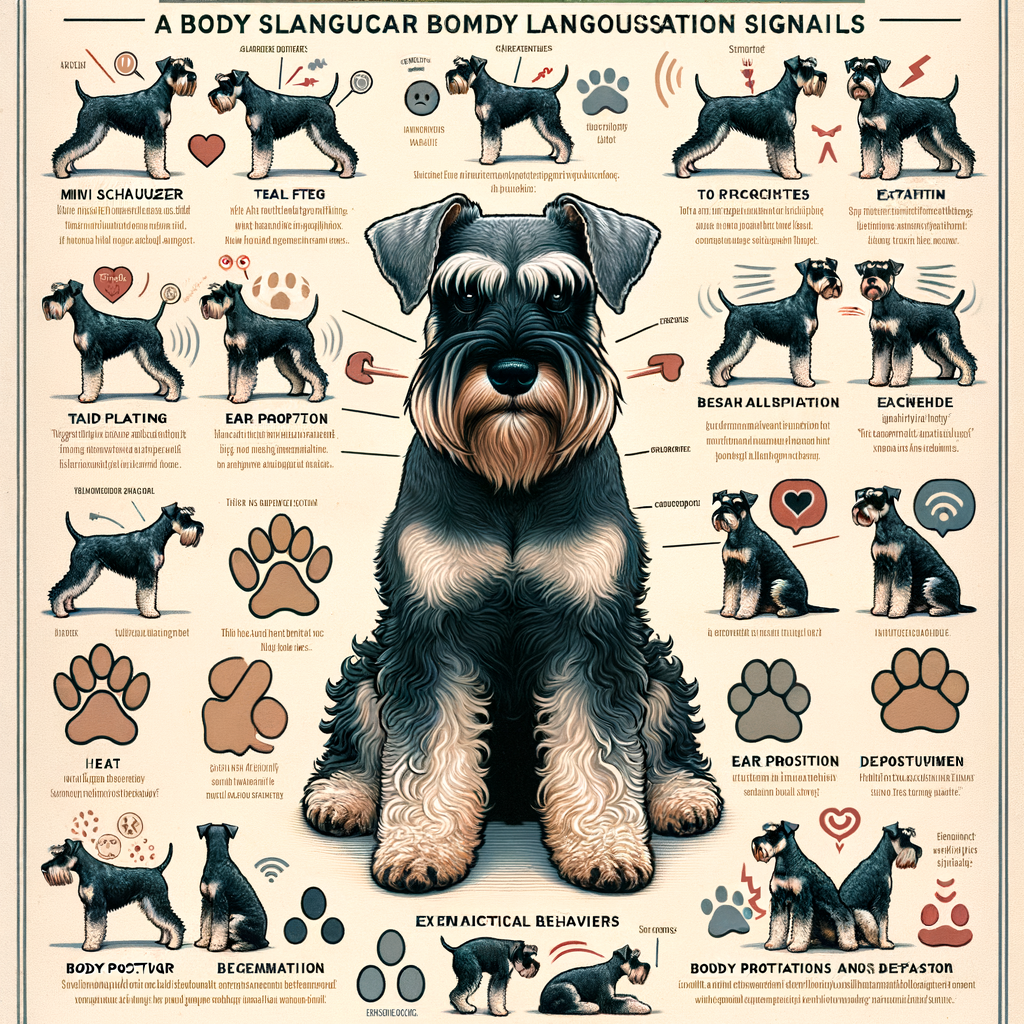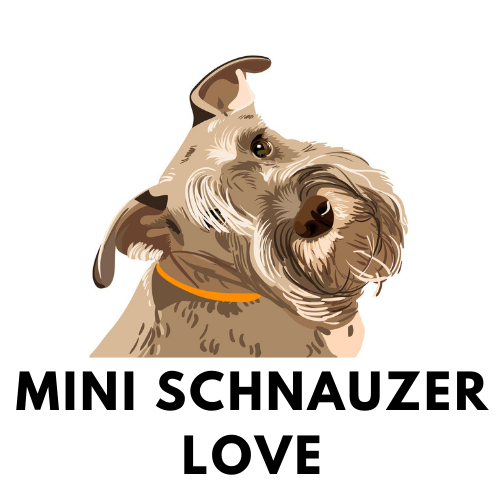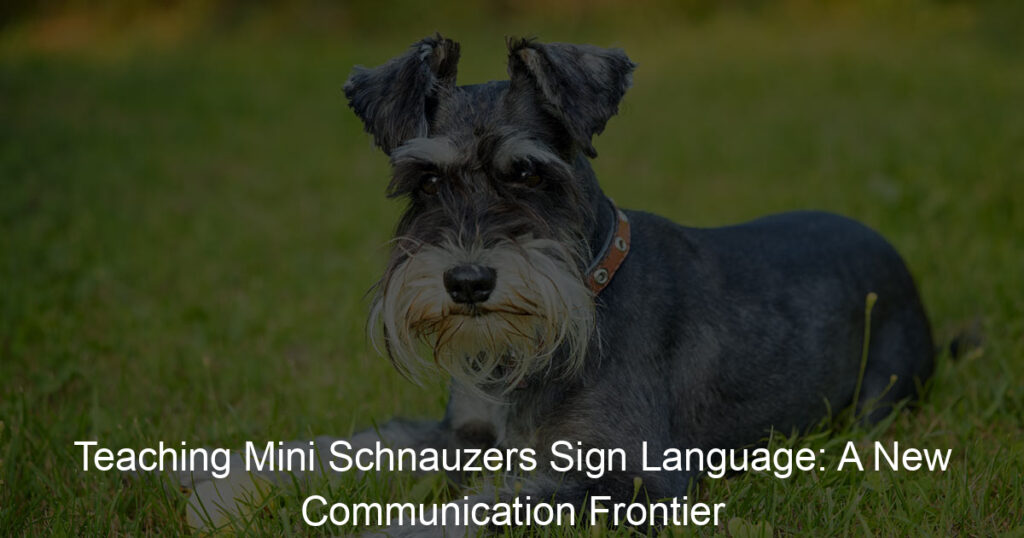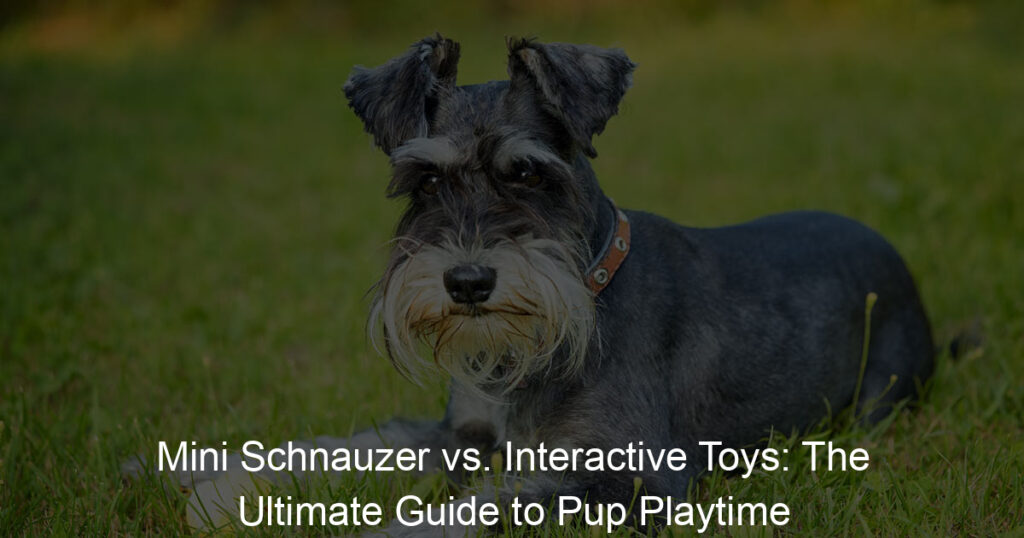
Introduction to Mini Schnauzer Behavior
Mini Schnauzers are a popular breed known for their distinctive looks and spirited personalities. Understanding their behavior is crucial for any owner or potential owner. This section will provide an overview of Mini Schnauzer characteristics and explain the importance of understanding dog body language.
- Overview of Mini Schnauzer characteristics
- Importance of understanding dog body language
Mini Schnauzers are small dogs with a big personality. They are known for their intelligence, energy, and loyalty. These dogs are highly trainable and love to be the center of attention. They are also known for being vocal and can be quite protective of their family. Despite their size, Mini Schnauzers are not afraid to stand their ground and can be quite assertive when they feel threatened.
Understanding your Mini Schnauzer’s body language is key to building a strong and healthy relationship with your pet. Dogs communicate primarily through body language, and being able to interpret these signals can help you understand your dog’s needs and feelings. This can also help prevent potential behavioral problems and ensure your dog’s well-being.
By understanding the behavior and body language of your Mini Schnauzer, you can ensure a harmonious and loving relationship with your pet. In the following sections, we will delve deeper into understanding Mini Schnauzer communication, signs of stress, and provide case studies for better comprehension.
Understanding Mini Schnauzer Communication
Communication is a vital aspect of any relationship, including the one between you and your Mini Schnauzer. Understanding your pet’s signals can help you respond appropriately and build a stronger bond.
Interpreting Mini Schnauzer Signals
Mini Schnauzers, like all dogs, communicate primarily through body language. By observing and understanding these signals, you can better understand your pet’s needs and emotions.
- Common Mini Schnauzer Body Language Signals
- Tail Wagging: This usually indicates happiness or excitement, but the speed and direction of the wag can also provide more information.
- Ear Position: Ears held high and forward indicate alertness, while ears pulled back often signify fear or submission.
- Body Posture: A relaxed body posture usually means a relaxed dog, while a stiff body can indicate tension or anxiety.
- How to Respond to These Signals
- Positive Reinforcement: Reward good behavior with treats, praise, or playtime. This encourages your dog to repeat the behavior in the future.
- Comforting: If your dog shows signs of fear or anxiety, try to comfort them. This can be as simple as speaking in a soft, soothing voice or providing a safe space for them to retreat to.
- Distraction: If your dog is showing signs of aggression or over-excitement, try to distract them with a toy or a command.
There are several common body language signals that Mini Schnauzers use to communicate. Here are a few:
Once you understand your Mini Schnauzer’s signals, it’s important to respond appropriately. Here’s how:
Remember, every Mini Schnauzer is unique and may communicate in slightly different ways. The key is to spend time with your pet, observe their behavior, and respond with love and patience.
Mini Schnauzer Comfort Signs
Understanding the signs of comfort in your Mini Schnauzer is crucial for maintaining a healthy and happy relationship with your pet. These signs indicate that your dog feels safe, content, and relaxed in its environment. Let’s explore these signs and learn how you can promote them.
- Signs of Contentment and Relaxation
- Tail Wagging: A relaxed, low wagging tail is a good sign. It shows your Mini Schnauzer is happy and content.
- Relaxed Body: A relaxed body posture, with no stiffness, indicates comfort.
- Play Bow: This is when your dog lowers its front legs and raises its back end. It’s a sign of happiness and a desire to play.
- Sighing or Purring: Yes, dogs can purr too! A deep sigh or a purr-like sound often indicates contentment.
- How to Promote These Comfort Signs in Dogs
- Regular Exercise: Regular walks and play sessions can help keep your Mini Schnauzer happy and content.
- Positive Reinforcement: Rewarding good behavior with treats, praise, or petting can promote feelings of contentment.
- Consistent Routine: Dogs thrive on routine. A consistent daily schedule can make your Mini Schnauzer feel secure and relaxed.
- Quality Time Together: Spending quality time with your dog, whether it’s cuddling on the couch or playing fetch in the park, can greatly enhance their sense of comfort and happiness.
Mini Schnauzers, like all dogs, have their unique ways of showing contentment and relaxation. Here are some common signs:
Promoting these comfort signs in your Mini Schnauzer involves creating a safe, loving, and stimulating environment. Here are some tips:
Remember, every Mini Schnauzer is unique. What works for one might not work for another. Pay close attention to your dog’s behavior and adjust your strategies accordingly. With patience and understanding, you can help your Mini Schnauzer feel more comfortable and content.
Signs of Stress in Mini Schnauzer
Understanding the signs of stress in your Mini Schnauzer is critical for their health and happiness. Stress can manifest in various ways, and it’s essential to be aware of both physical and behavioral signs. Let’s delve into the common symptoms of stress in dogs, particularly in Mini Schnauzers.
Dog Stress Symptoms
Stress symptoms in dogs can be categorized into two main types: physical and behavioral. Each category has specific signs that you should be aware of.
- Physical signs of stress in dogs
- Behavioral signs of stress in Mini Schnauzer
Physical signs of stress can be quite noticeable if you know what to look for. These may include excessive panting, drooling, shedding, or changes in appetite. Your Mini Schnauzer may also show signs of restlessness, such as pacing or shaking. It’s important to note that these symptoms can also indicate other health issues, so it’s crucial to consult with a veterinarian if you notice any of these signs.
Behavioral signs of stress in Mini Schnauzers can be more subtle than physical signs. These may include changes in their usual behavior, such as increased aggression or withdrawal. Your Mini Schnauzer may also become excessively clingy or start to display destructive behaviors like chewing on furniture or excessive barking. Remember, these behaviors are not your pet being ‘naughty’ – they are likely a cry for help.
In conclusion, understanding the signs of stress in your Mini Schnauzer is the first step towards helping them. If you notice any of these symptoms, it’s important to take steps to alleviate their stress and consult with a professional if necessary.
How to Alleviate Stress in Your Mini Schnauzer
Stress can affect your Mini Schnauzer’s health and happiness. It’s important to know how to help them relax and feel secure. Here are some effective calming techniques and advice on when to seek professional help.
- Effective Calming Techniques
- Regular Exercise: Regular physical activity can help reduce stress levels. Aim for at least 30 minutes of exercise a day, such as a walk or playtime in the yard.
- Consistent Routine: Dogs thrive on routine. Try to feed, walk, and play with your Mini Schnauzer at the same times each day.
- Comforting Environment: Create a safe and comfortable space for your dog. This could be a quiet room with their favorite toys and a cozy bed.
- Positive Reinforcement: Reward your Mini Schnauzer for calm behavior. This could be a treat, praise, or a favorite toy.
- When to Seek Professional Help
- Your Mini Schnauzer’s stress symptoms are severe or worsening.
- Your dog’s behavior has changed drastically.
- Your Mini Schnauzer is showing signs of physical discomfort or pain.
- Your dog is not eating or drinking normally.
There are several calming techniques that can help your Mini Schnauzer cope with stress. Here are a few:
If your Mini Schnauzer’s stress symptoms persist despite your best efforts, it may be time to seek professional help. Here are some signs that you should consult a veterinarian or a professional dog behaviorist:
Remember, every dog is unique. What works for one Mini Schnauzer may not work for another. It’s important to be patient and persistent. With time and effort, you can help your Mini Schnauzer feel more relaxed and secure.
Case Studies: Mini Schnauzer Behavior
Let’s delve into some real-life examples to better understand the behavior of Mini Schnauzers. These case studies will shed light on how to identify and address signs of stress, as well as how to promote comfort in your Mini Schnauzer.
- Case Study 1: Understanding and Addressing Signs of Stress
- Case Study 2: Promoting Comfort Signs in a Mini Schnauzer
Meet Max, a two-year-old Mini Schnauzer. His owners noticed that Max was showing signs of stress, such as excessive barking, pacing, and loss of appetite. They decided to consult a professional dog behaviorist to help Max.
The behaviorist suggested that Max’s stress might be due to a lack of physical activity and mental stimulation. They recommended increasing Max’s daily walks and introducing puzzle toys. After implementing these changes, Max’s stress signs significantly reduced. This case study highlights the importance of understanding and addressing stress signs in Mini Schnauzers.
Next, we have Bella, a three-year-old Mini Schnauzer. Bella’s owners wanted to ensure she was comfortable and happy in her home environment. They noticed Bella was most relaxed when she had her own space, so they created a cozy corner just for her.
They also made sure to spend quality time with Bella every day, playing her favorite games and teaching her new tricks. This not only kept Bella mentally stimulated but also strengthened their bond with her. As a result, Bella started showing more comfort signs, such as relaxed body posture and wagging tail. This case study demonstrates how promoting comfort signs can enhance a Mini Schnauzer’s well-being.
In conclusion, understanding your Mini Schnauzer’s behavior is crucial for their overall well-being. By recognizing and addressing signs of stress, as well as promoting comfort signs, you can ensure your Mini Schnauzer leads a happy and healthy life.
Key Takeaways: Decoding Your Mini Schnauzer
As we conclude our exploration of Mini Schnauzer behavior, let’s recap the most important points. These key takeaways will help you better understand and care for your furry friend.
- Importance of understanding your Mini Schnauzer’s body language
- Recognizing and addressing signs of stress
- Promoting comfort and happiness in your Mini Schnauzer
Just like humans, Mini Schnauzers communicate a lot through their body language. By observing their posture, tail wagging, ear position, and facial expressions, you can understand what they’re feeling. For instance, a relaxed body and wagging tail usually mean they’re happy, while a tucked tail and flattened ears might indicate fear.
Stress in Mini Schnauzers can manifest in many ways, including excessive barking, pacing, or even aggression. It’s crucial to identify these signs early and take steps to alleviate their stress. This could involve providing a safe space, reducing noise levels, or consulting with a vet or dog behaviorist.
Ensuring your Mini Schnauzer’s comfort and happiness involves more than just meeting their basic needs. Regular exercise, mental stimulation, and plenty of love and attention are all vital. Remember, a happy Mini Schnauzer is a healthy Mini Schnauzer.
In conclusion, understanding your Mini Schnauzer’s behavior is key to ensuring their well-being. By learning to decode their body language, recognizing signs of stress, and promoting their comfort and happiness, you can build a stronger bond with your furry friend and ensure they live a happy, healthy life.














